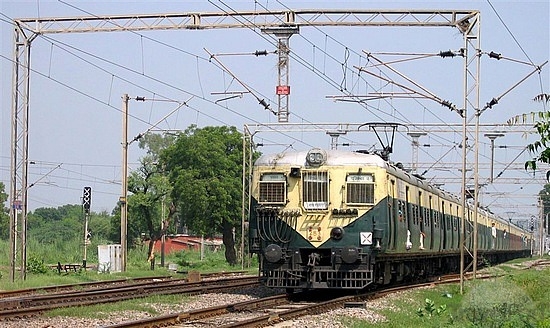Electrical Multiple Unit – a best mode of transport
Electrical Multiple Unit popularly called EMU is a very popular train configuration for sub-urban travel. EMU services are running presently in Mumbai (popularly called Local), Delhi (EMU), Kolkata (EMU), Chennai (EMU), Hyderabad etc. These services are very popular among daily commutator for
- In-time services
- Reliability in services with very rare failure
- Very low fare
- Vendor compartment to carry daily market products such as milk, vegetables, Tiffen supply in offices
2. It is called Electrical Multiple Unit as it consists of multiple motored vehicle built-in the train composition.
- It is dis-similar to a locomotive hauled train wherein the locomotive is attached to passenger carrying coaches. EMU has the advantage to reverse at terminal within 2 minutes. In a loco hauled train, locomotive hasto be reversed at the terminal andminimum 30 minutesare required for the purpose and during that period running of through trains is also restricted.
- EMU services improve safety because the movement of rolling stock over crossover is reduced which is always a concern towards the safety.
- It improves sectional capacity because of no reversal using crossover.
- One unit generally consists of three coaches of which one motor coach and shown by nomenclature like 1 (MC) +2 (TC). Theseare multiplied as two, three or four.
- So far maximum 12 coach EMU coaches trains are in service in Mumbai
- Few trains in Mumbai suburban are with 15 trains and limitation is only due to platform length and availability of coaches .
- EMU services in Delhi were introduced to facilitate easy travel to Delhi population when Delhi hosted 1982 Asian games. It is to be noted that EMU stock is 12 feet wide and accordingly platform at Railway station is designed to suit this width as well high level platform as EMU trains are without steps. It was for this reason that the introduction of EMU services was limited as it was requiring expenditure to modify the platform of the stations. While extending EMU services in Delhi, all stations on a particular route called circular Railway were modified for this purpose.
- An innovative thought emerges. It was decided to have 10 foot wide coaches in similar composition so that platform constraint is eliminated. This stock is called Mainline Electrical Multiple Unit (MEMU). This was an immediate success providing fast and reliable service connecting big cities with smaller cities over a distance of about 120-160 Km. MEMU services were in line with EMU, therefore, not provided with toilet facility. For this reason limitation of distance up to 120 Km was fixed. This was one of the passenger grievance and represented at different forum and finally Indian Railway decided to provide one toilet per unit.
- With the success of MEMU, it was decided to introduce DEMU (Diesel Multiple Unit) on similar lines for non-electrified route. It was also again a great success.
2. Even with the success of MEMU services as a most passenger friendly mode of transport, it could not be introduced with the same enthusiasm over Indian Railways. It was requiring the replacement of existing loco hauled trains by newly manufactured MEMU coaches with maintenance facilities different to what was already existing over Indian Railways. It is now only that complete shift to MEMU services is possible. Progress of introducing of MEMU and DEMU services over Indian Railways during the last 20 years has been very slow. The success story of MEMU was basically on two accounts namely reliability and on time run. Then why not extend this for other long distance trains up to 500 Km. with little modifications. It is similar to the concept of Train Set in European countries such as 
- Toilet facility
- Few Air Conditioned Coaches
- Maximum permissible speed raised to 120 Kmph
It is unfortunate that Indian Railway Management always looking for importing technologies from developed countries but have never encourage development of in-house technologies. Development of WAG7 and WAP4 locomotive is the demonstration of what in-house development can produce with what ever resources we have. Now with three phase technologies with bogie design available, it should not be difficult for Indian Railways to develop Train Set meeting the demand of large Indian population. There is a need to dump words such as State of the Art technologies and Center of Excellence unless it show in-house ability. The word “State of the Art Technologies” is very popular among decision makers to prove action for import of technologies.
3. MEMU is the most successful cost-effective option with adoption of few more technologies to meet the transport challenge of sub-urban network all around metropolitan cities. It is unfortunate that the city planners like National Capital Region Transport Corporation is planning independent suburban network at an exorbitant cost. In order to justify the IRR, the ridership is inflated by the consultants. The ridership is cleverly inflated with a many riders so that if there is failure, there is an escape route for the consultant. Read more: http://globalrailelectrica.com/mass-rapid-transit-system/mass-rapid-transit-system-suburban/
Proposal
State Government shall come forward to join hands with Indian Railway to improve the Rail infrastructure with MEMU service. State for a win-win situation for the passenger of his State. Passenger is benefit with fast, quick, reliable and very low fare service which no other transport system will ever match.
You may also like:
- An alternative to Rapid Rail Transport Corporation for transport need…
- EMU/MEMU for the future of Indian Railways
- Global Rail Technologies off the Shelf
- MRTS-Bangalore Sub-urban Rail Corporation
- Addressing Safety and Security issues relating to EMU Sub-urban Services
- Why Tramways not making headway in planned cities?
memu teaching metarial in hindi